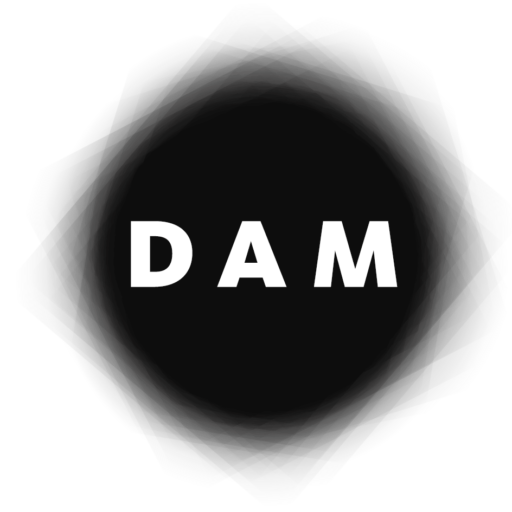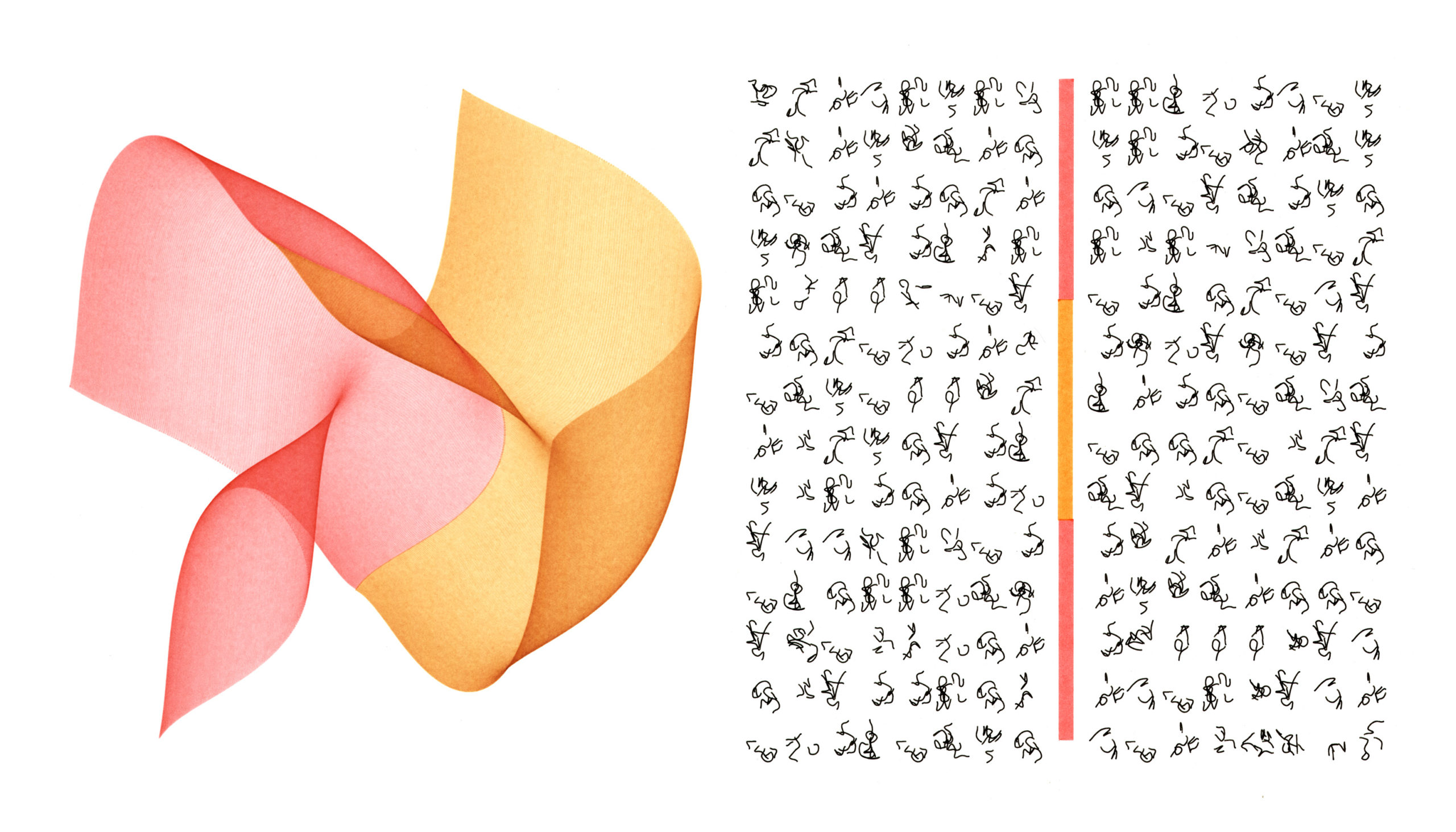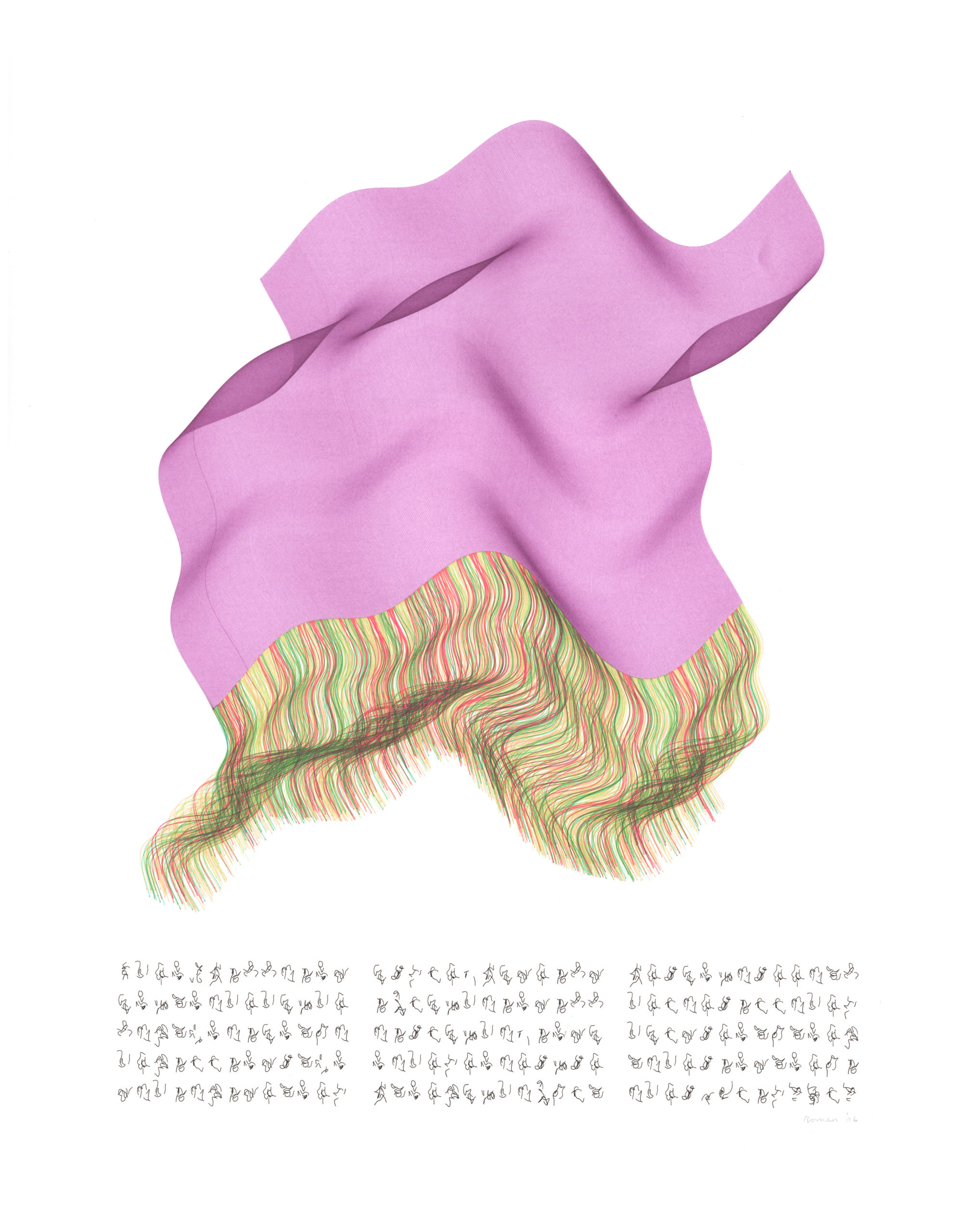
Roman Verostko was an artist who created computer-generated artworks using his own algorithms. He started writing programs for algorithmic art in the late 1970s and early 1980s and developed a distinct visual style by using oriental brushes in a pen plotter. In 1995, he co-founded the artists group the Algorists with Jean-Pierre Hébert.
Website of Roman Verostko:
www.verostko.com
Algorithmic Poetry (2010)
This series of algorithmic drawings created with brushes and pens mounted on a drawing machine are meant to express “the joy of the digital,” according to the artist. He was inspired by the memories of walking with his wife Alice in natural parks, seeking to marry “the stark logic of algorithms generate exuberant playfulness and quiet undulation.”
Rocktown Scrolls (2006)
The Rocktown Scrolls is a series of computer generated pen and ink drawings named after the artist’s hometown, in which colorful shapes are accompanied by texts from different sources (such as a poem by William Blake, a play by William Shakespeare, or a passage from the Bible) coded into algorithmically generated glyphs.
Pearl Park Scriptures (2004-2005)
This series is influenced by the morning walks that the artist took around Pearl Park in Minneapolis. Inspired by the decorated pages of medieval illuminated manuscripts, the compositions are dominated by a drawing in bright colours and lines of glyphs that were generated for these works. Some glyphs have no meaning, while others present in coded form text by Darwin, Lao Tsu, the Apache Indians, or the book of Genesis.
Pen plotted work (1988-1998)
Verostko started to define his particular visual style during this period using a pen plotter and a collection of brushes. The pen plotter was controlled by a software written by the artist.
Early Algorist Period (1980-1988)
This period starts with Verostko’s first exhibition piece, The Magic Hand of Chance (1982-85), which used a program written by the artist that generated in real time a series of six visual improvisations that were displayed on a monitor. He later on developed his first algorithmic drawings on paper, which have a certain resemblance to his earlier work.
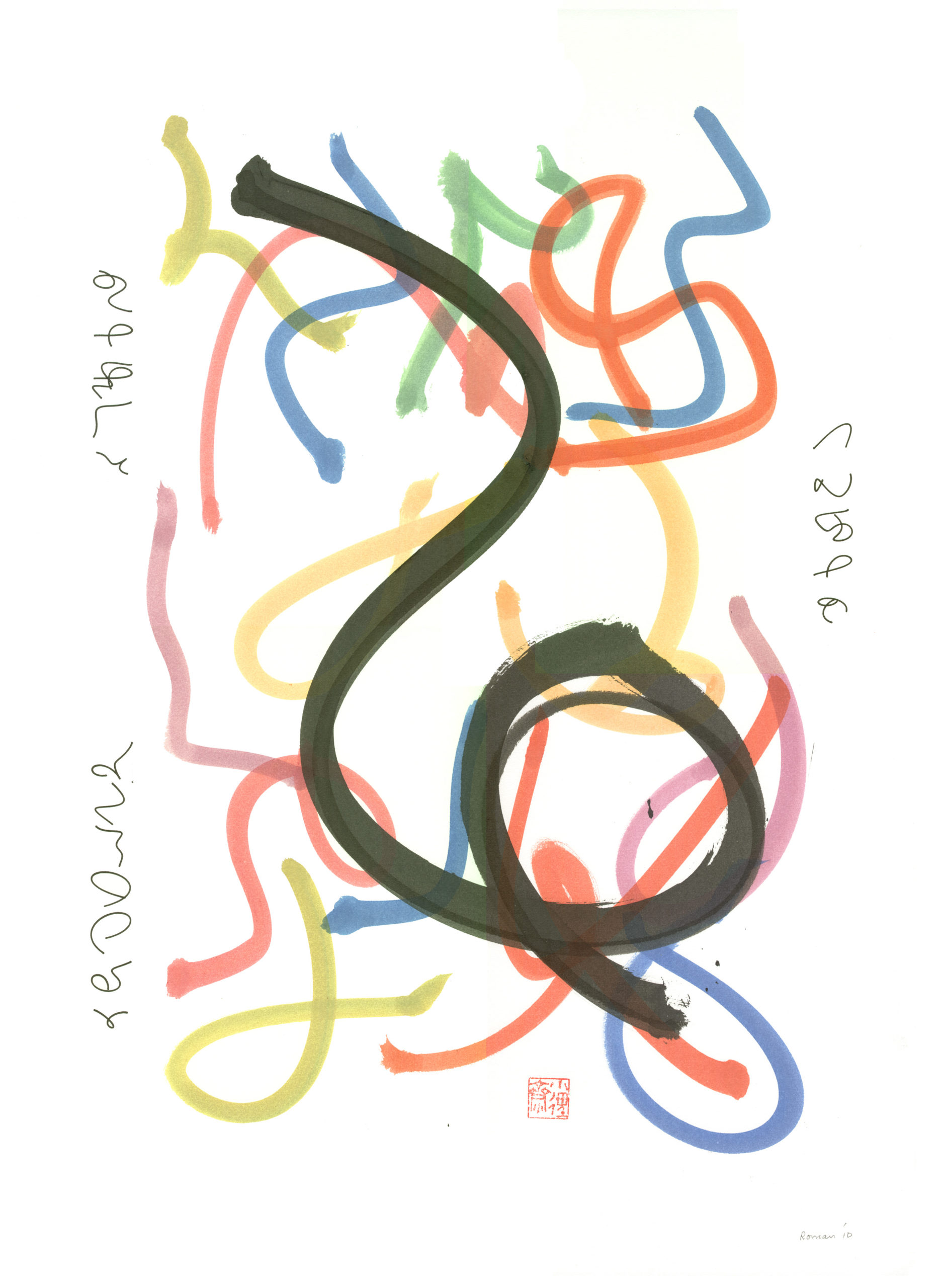
Imaging the Unseen
A statement on my pursuit as an artist
Roman Verostko, 2004
From Source. My algorithmic work is rooted in the tradition of early 20th Century artists who sought to create an art of pure form. Influenced by the work and writings of pioneers like Malevich and Mondrian my work turned to a lifelong quest for an art of pure form. This quest, to create visual form with a life of its own, has dominated my work since the 1950’s. My current work continues the same quest for “pure form” that seduced early 20th Century purists.
Transition to algorithmic form generators.
In 1970, through a course in Computer Concepts at the Control Data Institute in Minneapolis, I was introduced to FORTRAN. I experienced the awesome “form-generating” leverage of algorithms executed with computing power. With algorithms that required extensive computation for generating form we could now compose the “score” for drawing.
The advent of personal computers brought that leverage into my studio where I could spend countless hours working with my own computer coding routines that I viewed as my “score for drawing”. Since then my work has concentrated on developing and refining a program of “form-generators” that grew from 25 years of experience as a painter.
For me these procedures opened new frontiers of visual form, form we could never visualize without computing power. These art forms do not describe or refer to other realities – rather they themselves are the “realities”; they have a visual life of their own.
Titles.
Title sources vary. Some titles derive from evocative qualities I see in the finished form. Some works remain untitled and are given numbers much like musical compositions. Often works are titled to celebrate a text, commemorate a person, or mark an event. However the art forms themselves are always presented as visual realities to be experienced, similar to the way one might experience a musical form, a flower, or a tree.
Technical Procedure.
By 1982 I had developed elementary computer code for initiating and improvising art-form ideas. These instructions included “form-generating” routines that continued my quest for pure form. With these generators I could explore visual possibilities, make choices, refine forms, and compose a procedure for creating art. The finished work is drawn with ink pens mounted on the drawing arm of a pen plotter. Controlling algorithms for all procedures are under continuing development in a program of routines I have titled “Hodos”, the Greek term for “pathway”.
Materials.
Most of my algorithmic works are original pen and ink drawings on rag paper. Technical pens with refillable inkwells employing permanent acrylic inks execute the drawings. Since the mid 1980’s all drawings have been executed with Houston Instruments multi-pen plotters coupled to PC’s. Some works include occasional brush strokes. For this purpose I devised an interactive routine with the pen plotter; the routine pauses the machine, as needed, so I can load a paint brush and mount it on the pen plotter drawing arm for executing brush strokes. The plotter uses the brush in lieu of ink pens. In some instances I have also used self-inking brushes in lieu of pens.
The Code.
My software is written in elementary BASIC with DMPL as the command language for driving the plotter. Historical routines dating back to the 1980’s can be called on from the controlling program. A new work could be created today (2015) with routines dating from the 1980’s.
As an artist my great interest has always been mastering a technique for creating an art object. Elementary pen plotting tools and simple programming techniques have provided me with more challenges than I can exhaust in my lifetime. After more than 50 years and thousands of drawings I have learned a lot about ink viscosities, pigments, paper surfaces, the honing of pen tips, and writing software fixes. Yet, I feel that I have only begun to explore the art of drawing with pen and paper

Tarrs, PA (USA), 1929-Minneapolis, MN, (USA) 2024
Roman Verostko graduated from the Art Institute of Pittsburg in 1949 and entered monastic life at St. Vincent Archabbey a year later. During his time as a monk he continued his artistic practice, studied philosophy and theology at St. Vincent College, and pursued a Master in Fine Arts at Pratt Institute in 1961 as well as studies in art history at New York University and Columbia University from 1961 to 1962. He also travelled to Paris, where he studied printmaking and took courses at the École du Louvre from 1962 to 1963. His work in Paris was influenced by Stanley William Hayter, from whom he learned printmaking and methods for the semi-automated production of images as practiced by the Surrealists. This would later drive his interest in using algorithms to create art. During this period he also served as Staff Editor for Art & Architecture for the first edition of the New Catholic Encyclopaedia (McGraw Hill, 1967). After departing from monastic life in 1968, he joined the humanities faculty at the Minneapolis College of Art & Design, where he became Professor Emeritus in 1994, and wrote his first programs at the Control Data Institute in Minneapolis.
In 1970 he joined the Center for Advanced Visual Studies at M.I.T. as a visiting scholar and worked with Gyorgy Kepes. However, as stated by Verostko, he actually began working with algorithms “with the first personal computers, the Apples we had in ’78 and the IBM that came out in August 1981.” His first computer-generated work was a light show titled The Magic Hand of Chance (1982), written in BASIC on an IBM PC. At this time, he created the Hodos software for computer art and also started producing his first algorithmic drawings using a pen plotter (Houston Instruments DMP-52), which he adapted in 1987 to use oriental brushes instead of technical pens. In 1995, he co-founded the artists group the Algorists with Jean-Pierre Hébert, following a panel titled “Art and Algorithms” at SIGGRAPH. According to Hébert, algorists are “artists who create art using algorithmic procedures that include their own algorithms.” The term therefore designates pioneers of algorithmic art such as Charles Csuri, Georg Nees, Frieder Nake, Vera Molnar, Mark Wilson, Manfred Mohr, Hiroshi Kawano, Herbert Franke, Harold Cohen, and Edward Zajec. While not constituting an artists’ collective, the term algorist was coined to create a shared identity for the artistic practice of these pioneers and differentiate their work from that of other artists using computer software.
Verostko has taken part in notable exhibitions such as SIGGRAPH ’90 Art Show (Computer Museum, Boston, 1991), ISEA (Sydney, 1992), ARTEC ’95, International Biennial (Nagoya City Science Museum, 1995), Genetic Art-Artificial Life (Ars Electronica, Linz, 1993), Code: the language of our time (Ars Electronica, Linz, 2003), The Algorithmic Revolution (ZKM, Karlsruhe, 2005), Feedback (Laboral Centro de Arte y Creación Industrial, Gijón, 2007), Digital Pioneers (Victoria and Albert Museum, London, 2009), Drawing with Code: Works from the Anne and Michael Spalter Collection (DeCordova Sculpture Park and Museum, Lincoln, Massachusetts, 2011), The American Algorists: Linear Sublime (New York Digital Salon, 2013), Coder le Monde (Coding the World) (Centre Pompidou, Paris, 2018), and Chance & Control: Art in the age of computers (Victoria & Albert Museum, London, 2018). In 2019, the Minneapolis College of Art & Design Galleries held a retrospective of his work titled Roman Verostko And The Cloud Of Unknowing. In 2009, ACM SIGGRAPH presented him with the Distinguished Artist Award for Lifetime Achievement.
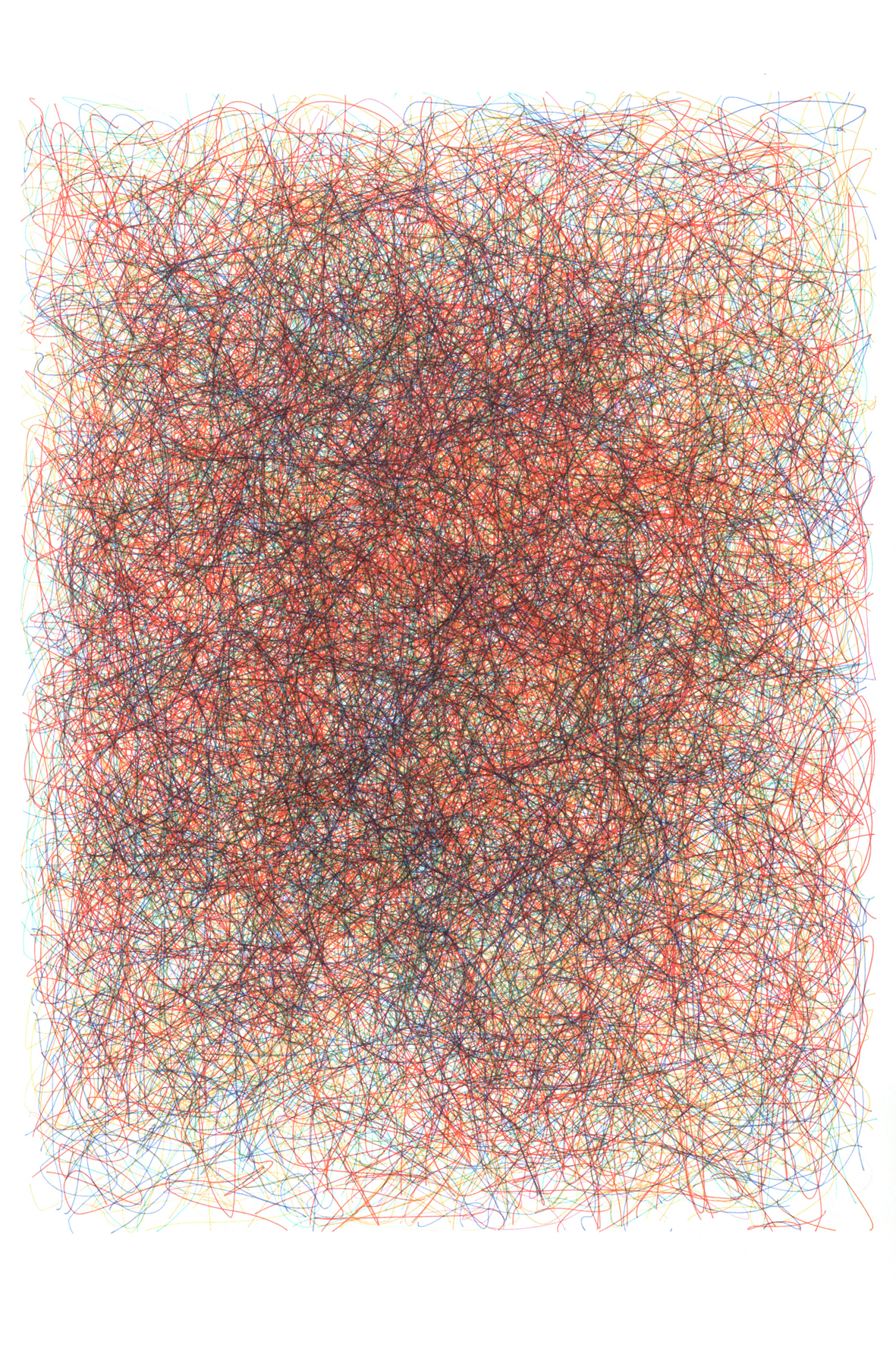
Verostko, R. (1988). Epigenetic Painting. Software As Genotype, A New Dimension of Art. First International Symposium on Electronic Art (FISEA’88). [EN]
–– (1994). Algorithms and the Artist. ISEA 94 Helsinki. [EN]
–– (2000). Algorithmic Art: Composing a Visual Arts Score. Roman Verostko. [EN]
–– (2004). Imaging the Unseen. A Statement on my Pursuit as an Artist. Roman Verostko. [EN]
–– (2005). Illuminating A Universal Turing Machine. Roman Verostko. [EN]
–– (2014). The Algorists. THE ALGORISTS. [EN]
Morgan, K. and Pankau, M. (2014). Roman Verostko and the Cloud of Unknowing. From Ideas in Mind to Ideas in Code. Minneapolis: Minneapolis College of Art and Design [EN]
Taylor, Grant D. (2013). The American Algorists: Linear Sublime. Hébert, Mohr, Verostko, Wilson. Exhibition Catalogue. School of Visual Arts, New York City; Suzanne H. Arnold Art Gallery, Lebanon Valley College, Annville. [EN]

Publications
2009
SIGGRAPH Distinguished Artist Award: Roman Verostko. Leonardo – Volume 42, Number 4, August 2009, pp. 297-297
Honor Bedard & Douglas Dodd. V&A Pattern: Digital Pioneers. V&A Publishing, Victoria & Albert Museum, London, 2009. ISBN 9781 1851775873
Wolf Lieser (ed.). The World of Digital Art. Ed Tandem Verlag GmbH H.F.Ullman. English and German Editions, 2009, ISBN 978-8331-5337-2
2006
Hortus Conclusus Nazarenus: Flowers of Learning. Spalding University, Louisville, Kentucky, USA, 2006.
Vlatko Čerić. Legitimnost algoritamske grafičke umjetnosti (I). GRAFIKA III, No.7-8, Oct 2005-March 2006, pp 18-22, Zagreb 2006.
James Faure Walker. Painting the Digital River. Prentice Hall, 2006. See Chapter 7, “Strange Plants”, esp. pp. 234 ff
2005
Louise Poissant et Ernestine Daubner (eds.). Art et Biotechnologies, Collection Esthétique. Presses de l’Université du Quebec, Publications de l’Université de Saint-Étienne, 2005, ISBN 2-7605-1328-9.
Alice Wagstaff. Roman and the Algorithmic Revolution. PhD thesis about Roman Verostko: Pearl Park Scriptures. Hoffman Druck, GmbH, Wolgast.
2003
Paul Schmitt. Le retour de la Peinture. Pixel, créativité, reviewing Siggraph 03: Art Gallery – p.68-69 numéro 82, 2003.
Roman Verostko. Epigenetic Art Revisited: Software as Genotype. In: Gerfried Stocker & Christine Schöpf (eds.). Code – the language of our time. Ars Electronica 2003. Ostfildern-Ruit: Hatje Cantz Verlag, pp.156-167.
2002
Maureen A. Nappi. Language, Memory and Volition: Toward an Aesthetics of Computer Arts. PhD Thesis. Chapter V discusses the aesthetics of Roman’s “Illuminated Universal Turing Machine”, pp. 163-180, New York University, Department of Art & Art Professions, 2002.
Steve Dietz. Interview with Roman Verostko, 6/27/2002. Walker Art Center, Minneapolis. Video documentary.
Linda Candy and Ernest Edmonds. Explorations in Art and Technology. London: Springer, pp. 131 ff.
2001
Review: Machine-Made Works That Look Crafted by Hand”, Chronicle of Higher Education, March 2nd, 2001.
Megan Bates. Algorithms + computer + canvas = art: Roman Verostko/Arizona State University. The Arizona Republic, Feb. 1, 2001.
1999
Ann Morgan Spalter. The Computer in the Visual Arts. Addison-Wesley Pub Co; ISBN: 0201386003; 1st edition.
1996
Gregg Smith. Roman Verostko. PIXEL, Le magazine des nouvelles images, No. 29, Paris 1996. p 32ff.
William Zimmer. ART; A Family and Its Gallery Click on the Future. New York Times, 2/18/1996.
1993
Roman Verostko in Der Prix Ars Electronica: Internationales Kompendium der Computerkunste, pp 48-49, Veritas Verlag, Linz, Austria, 1993, ISBN 3-7058-0086-8.
Computer art wizard expands our parameters of consciousness. The Edge, December 1992/Jan 1993, p. 5.
1972
Don Morrisson. Charming is best word for describing Verostko’s paintings. The Minneapolis Star, Nov. 16, 1972, p.78.
1968
Review: Sculptures de Ciment. Monastery de Saint-Vincent, Roman Verostko. Art D’Église No: 142 1968 (Brughes).
1967
Community and Privacy for Benedictines. Architectural Record, November 1967.
1965
Roman J. Verostko, Exhibition Catalogue. Westmoreland County Museum of Art, Greensburg, Pennsylvania 1965.
In one of his final interviews before his passing on June 1, 2024, at the age of 94, digital art pioneer Roman Verostko discussed his life’s work and algorithmic art with artist and curator Patrick Lichty in his home in Minneapolis. The interview was commissioned by DAM to honor Verostko’s legacy in the field.
